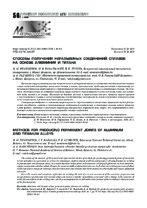Способы получения неразъемных соединений сплавов на основе алюминия и титана

Date
2020Publisher
Another Title
Methods for producing permanent joints of aluminum and titanium alloys
Bibliographic entry
Способы получения неразъемных соединений сплавов на основе алюминия и титана = Methods for producing permanent joints of aluminum and titanium alloys / Б. М. Немененок [и др.] // Литье и металлургия. – 2020. – № 1. – С. 56-64.
Abstract
Представлены результаты анализа теоретических и экспериментальных исследований способов получения неразъемных соединений разнородных металлов и сплавов, а также преимущества, проблемы реализации и перспективы использования процессов сварки трением с перемешиванием для соединения титановых и алюминиевых сплавов. Отмечается, что большинство исследований посвящено сварке трением с перемешиванием легких металлов, таких, как алюминий, медь, магний и их сплавы. Несмотря на большой научный и практический интерес, процессы сварки трением с перемешиванием сплавов и металломатричных композиционных материалов на основе алюминия и титана изучены менее тщательно и требуют дополнительного внимания. Учитывая разнообразие и сложность сварки трением с перемешиванием, отсутствие правильной оценки реакционной способности, свойств и конструктивных особенностей алюминиевых и титановых сплавов может привести к ряду проблем, связанных с изменением структуры материалов и дефектами зоны сварки, что сопровождается неизбежным ухудшением механических характеристик готовых соединений.
Abstract in another language
The results of the analysis of theoretical and experimental studies of methods for producing permanent joints of dissimilar metals and alloys are presented, as well as the advantages, implementation problems and prospects of using friction stir welding to join titanium and aluminum alloys. It is noted that most studies focus on friction stir welding of light metals such as aluminum, copper, magnesium and their alloys. Despite the great scientific and practical interest, the friction stir welding processes of alloys and metal-matrix composite materials based on aluminum and titanium have been studied less thoroughly and require additional attention. Given the variety and complexity of friction stir welding, the lack of a correct assessment of the reactivity, properties and design features of aluminum and titanium alloys can lead to a number of problems associated with a change in the structure of materials and defects in the welding zone, which is accompanied by the inevitable deterioration of the mechanical characteristics of the finished joints.
View/
Collections
- № 1[23]
